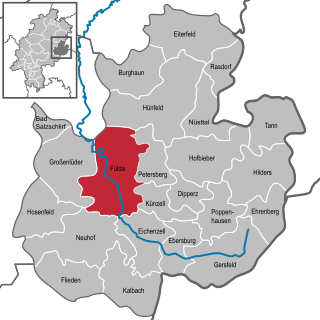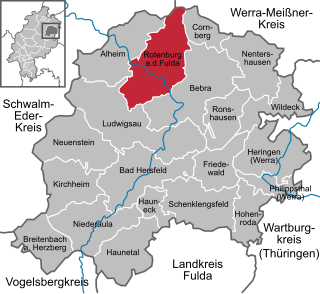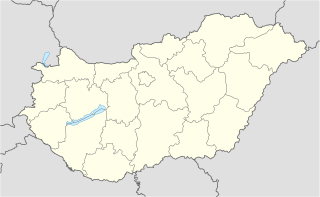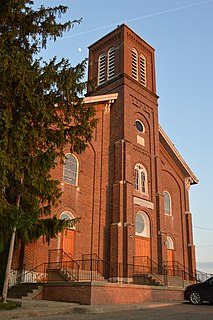
Saint Boniface, born Winfrid in the Devon town of Crediton, England, was a leading figure in the Anglo-Saxon mission to the Germanic parts of the Frankish Empire during the 8th century. He organized Christianity in many parts of Germania and was made archbishop of Mainz by Pope Gregory III. He was martyred in Frisia in 754, along with 52 others, and his remains were returned to Fulda, where they rest in a sarcophagus which became a site of pilgrimage. Boniface's life and death as well as his work became widely known, there being a wealth of material available—a number of vitae, especially the near-contemporary Vita Bonifatii auctore Willibaldi, legal documents, possibly some sermons, and above all his correspondence. He became the patron saint of Germania, known as the "Apostle of the Germans".

Fulda is a city in Hesse, Germany; it is located on the river Fulda and is the administrative seat of the Fulda district (Kreis). In 1990, the town hosted the 30th Hessentag state festival.

The Weser is a river in Northwestern Germany. Formed at Hannoversch Münden by the confluence of the rivers Fulda and Werra, it flows through Lower Saxony, then reaching the Hanseatic city of Bremen, before emptying 50 km (31 mi) further north at Bremerhaven into the North Sea. On the opposite (west) bank is the town of Nordenham at the foot of the Butjadingen Peninsula; thus, the mouth of the river is in Lower Saxony. The Weser has an overall length of 452 km (281 mi). Together with its Werra tributary, which originates in Thuringia, its length is 744 km (462 mi).

Fulda is a city in Murray County, Minnesota, United States. The population was 1,318 at the 2010 census.

Fulda is a Kreis (district) in the north-east of Hesse, Germany. Neighboring districts are Hersfeld-Rotenburg, Wartburgkreis, Schmalkalden-Meiningen, Rhön-Grabfeld, Bad Kissingen, Main-Kinzig, Vogelsbergkreis.

The Fulda is a river of Hesse and Lower Saxony, Germany. It is one of two headstreams of the Weser. The Fulda is 220.4 kilometres (137.0 mi) long.

Wartenberg is a community in the Vogelsbergkreis in Hesse, Germany.

The Rhön Mountains are a group of low mountains in central Germany, located around the border area where the states of Hesse, Bavaria and Thuringia come together. These mountains, which are at the extreme southeast end of the East Hesse Highlands, are partly a result of ancient volcanic activity. They are separated from the Vogelsberg Mountains by the river Fulda and its valley. The highest mountain in the Rhön is the Wasserkuppe which is in Hesse. The Rhön Mountains are a popular tourist destination and walking area.

The Fulda Gap, an area between the Hesse-Thuringian border and Frankfurt am Main, contains two corridors of lowlands through which tanks might have driven in a surprise attack by the Soviets and their Warsaw Pact allies to gain crossing(s) of the Rhine River. Named for the town of Fulda, the Fulda Gap became seen as strategically important during the Cold War of 1947-1991. The Fulda Gap roughly corresponds to the route along which Napoleon chose to withdraw his armies after defeat at the Battle of Leipzig. Napoleon succeeded in defeating a Bavarian-Austrian army under Wrede in the Battle of Hanau not far from Frankfurt; from there he escaped back to France.

The Russian Football Union is the official governing body of the sport of football in the Russian Federation. With headquarters in Moscow, it organizes Russian amateur and professional football, including the men's, women's, youth, beach football, futsal and Paralympic national teams. The RFS sanctions referees and football tournaments for Russian Football Premier League and most football leagues in Russia.

Rotenburg an der Fulda is a town in Hersfeld-Rotenburg district in northeastern Hesse, Germany lying, as the name says, on the river Fulda.

The Annales Fuldenses or Annals of Fulda are East Frankish chronicles that cover independently the period from the last years of Louis the Pious to shortly after the end of effective Carolingian rule in East Francia with the accession of the child-king, Louis III, in 900. Throughout this period they are a near contemporary record of the events they describe and a primary source for Carolingian historiography. They are usually read as a counterpart to the narrative found in the West Frankish Annales Bertiniani.

Fulda station is an important transport hub of the German railway network in the east Hessian city of Fulda. It is used by about 20,000 travellers each day. It is classified by Deutsche Bahn as a category 2 station. It is a stop for Intercity-Express, Intercity services and regional services. The original station was opened as part of the Frankfurt–Bebra railway in 1866. This was destroyed during the Second World War and rebuilt after the war. The station was adapted in the 1980s for the Hanover–Würzburg high-speed railway.

Borussia Fulda is a German association football club from Fulda, Hesse. The club was founded 4 July 1904 as FC Borussia 1904 Fulda and underwent a number of changes in 1923 when they were first joined by Radsportclub 1907 Fulda in July, and then by Kraftsportklub Germania Fulda in September. On 6 September 1923 the association was named 1. SV Borussia 04 Fulda.

Mucsi is a village in Tolna County, Hungary. The former German name was Mutsching.

Fulda is an unincorporated community in Harrison Township, Spencer County, in the U.S. state of Indiana. The Spencer County Memorial Forest features a World War II veterans memorial. There is a shooting match the first weekend of October.

The Diocese of Fulda is a Roman Catholic diocese in the north of the German state of Hessen. It is a suffragan diocese of the Archdiocese of Paderborn. The bishop's seat is in Fulda Cathedral.

Fulda Abbey, or the Princely Abbey of Fulda, or the Imperial Abbey of Fulda was a Benedictine abbey as well as an ecclesiastical principality centered on Fulda, in the present-day German state of Hesse. It was founded in 744 by Saint Sturm, a disciple of Saint Boniface. Through the 8th and 9th centuries, Fulda Abbey became a prominent center of learning and culture in Germany, and a site of religious significance and pilgrimage following the burial of Boniface. The growth in population around Fulda would result in its elevation to a prince-bishopric in the second half of the 18th century.
The SG Barockstadt Fulda-Lehnerz is a German association football club from the Lehnerz suburb of Fulda, Hesse.

Fulda is an unincorporated community in Noble County, Ohio, United States.






















